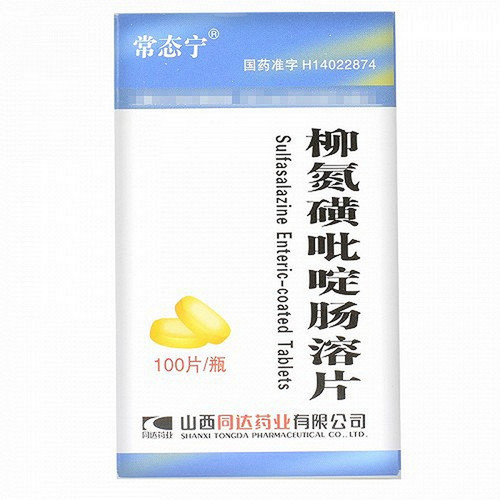Product Overview
[Drug Name]
Trade Name: Changchangning
English Name: Sulfasalazine Suppositories
Chinese Pinyin: Liudanhuangbiding Shuan
[Ingredients]
The main ingredient of this product is sulfasalazine.
[Properties]
Brown-yellow suppository made of a fatty matrix.
[Indications]
For inflammatory bowel diseases such as ulcerative colitis and nonspecific chronic colitis.
[Dosage and Administration]
Rectal administration. Severe patients should take one tablet each morning, noon, and evening after a bowel movement. Moderate or mild patients should take one tablet each morning and evening after a bowel movement. After significant improvement in symptoms, switch to a maintenance dose of one tablet each night or every other night, preferably before bedtime.
[Adverse Reactions]
Not yet known.
[Contraindications]
Contraindicated in patients allergic to sulfonamides.
[Precautions]
1. Contraindicated in patients allergic to sulfonamides.
2. During placement, a white frost may sometimes form on the surface of the plug due to the matrix. This is a normal phenomenon and does not affect the efficacy.
[Use in Special Populations]
Precautions for Children:
Since sulfonamides can compete with bilirubin for binding sites on plasma proteins, and the acetyltransferase system in newborns is not fully developed, the free blood concentration of sulfonamides increases, increasing the risk of kernicterus. Therefore, these drugs should not be used in newborns and children under 2 years of age.
Precautions for Pregnancy and Breastfeeding:
1. Sulfonamides can cross the placental barrier and reach the fetus. Animal studies have shown teratogenic effects. However, insufficient data are available from human studies. Therefore, their use should not be used by pregnant women.
2. Sulfonamides are secreted in breast milk, with concentrations reaching approximately 50% to 100% of the maternal blood concentration. These drugs may affect infants. Sulfonamides may cause hemolytic anemia in newborns with glucose-6-phosphate dehydrogenase deficiency. Therefore, their use should not be used by breastfeeding women.
Precautions for Elderly Patients:
Elderly patients are more likely to experience serious adverse reactions when using sulfonamides. Severe rash, bone marrow suppression, and thrombocytopenia are common serious adverse reactions in the elderly. Therefore, elderly patients should avoid using sulfonamides. When indicated, the use of sulfonamides should be carefully weighed.
[Drug Interactions]
1. Concomitant use with urinary alkalinizing agents can enhance the solubility of sulfonamides in alkaline urine, increasing their excretion.
2. Para-aminobenzoic acid can replace sulfonamides in bacterial uptake, antagonizing the antibacterial effects of sulfonamides. Therefore, the two drugs should not be used together.
3. When the following drugs are used together with sulfonamides, the latter can displace the protein binding sites of these drugs or inhibit their metabolism, resulting in prolonged drug action or toxicity. Therefore, the dosage of these drugs should be adjusted when used together with sulfonamides or after sulfonamides. These drugs include oral anticoagulants, oral hypoglycemic agents, methotrexate, phenytoin sodium, and thiopental sodium.
4. The combined use of myelosuppressive drugs and sulfonamides may enhance the adverse effects of these drugs on the hematopoietic system. If combined use of these two classes of drugs is indicated, close observation for possible toxic reactions should be conducted.
5. Long-term combined use of contraceptives (estrogens) with sulfonamides may reduce contraceptive reliability and increase the chance of extramenstrual bleeding.
6. The combined use of thrombolytics and sulfonamides may enhance their potential toxic effects.
7. The combined use of hepatotoxic drugs and sulfonamides may increase the incidence of hepatotoxicity. Liver function should be monitored in such patients, especially those taking these drugs for a long time and those with a history of liver disease.
8. The combined use of photosensitizing drugs and sulfonamides may result in additive photosensitivity.
9. Patients receiving sulfonamide therapy have an increased requirement for vitamin K.
10. Hexamine decomposes in acidic urine to produce formaldehyde, which can form an insoluble precipitate with sulfonamides. This increases the risk of crystalluria, and therefore, the combined use of these two drugs is not recommended.
11. Sulfonamides can displace the plasma protein binding sites of phenylbutazone, and their combined use can enhance the effects of phenylbutazone.
12. When used concomitantly with sulfonamides, sulfinpyrazone can reduce the latter's renal tubular secretion, resulting in elevated and prolonged blood concentrations and potentially toxicity. Therefore, the sulfonamide dosage may need to be adjusted during or after sulfinpyrazone treatment. When sulfinpyrazone treatment is prolonged, monitoring the sulfonamide blood concentration is advisable to facilitate dosage adjustments and ensure safe use.
13. When used concomitantly with digitalis or folic acid, the latter's absorption is reduced, leading to lower blood concentrations. Therefore, the effects and efficacy of digitalis must be monitored at all times.
14. Concomitant use with probenecid can reduce renal tubular sulfonamide excretion, leading to elevated blood sulfonamide concentrations, prolonged effects, and increased toxicity.
15. When used concomitantly with neomycin, neomycin inhibits intestinal flora, affecting the breakdown of this drug in the intestine and reducing its effectiveness.
[Pharmacological Actions]
Anti-inflammatory drug. Pharmacological studies of sulfasalazine suppositories in a rat model of immune ulcerative colitis compared the efficacy of anal suppositories and oral tablets administered orally. The results showed that the anal suppository was significantly more effective than the oral administration. (Absorption, Distribution, and Elimination) Sulfasalazine suppositories enter the intestine and are broken down by intestinal bacteria into sulfapyridine and 5-aminosalicylic acid, which is ultimately excreted in the feces. Sulfapyridine is absorbed into the bloodstream and ultimately excreted in the urine. In addition to the original form and sulfapyridine, acetylated and glucuronide conjugates of sulfapyridine are found in the bloodstream. Sulfapyridine and its acetylated form are excreted in the urine.
[Storage]
Store in a dark, airtight container.
[Specifications]
0.5g x 6 tablets
[Packaging]
Box
[Expiration Period]
36 months
[Approval Number]
National Medicine Standard H10900091
[Manufacturer]
Company Name: Shanxi Tongda Pharmaceutical Co., Ltd.








